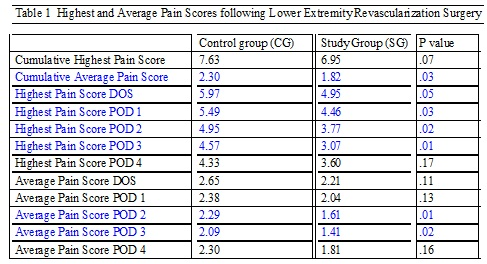|
Back to 2016 Karmody Posters
Postoperative Regional Local Anesthetic Infusion Decreases Pain Scores and Complications After Lower Extremity Revascularization Surgery
William P. Shutze, Sr.4, Tammy Fisher1, William P. Shutze, Jr.5, Yahya Daoud2, Jordan Schauer3, Emily Biller3, Nicholas Douville3, Joseph Liechty1, John Fullinwider1
1Baylor University Medical Center, Dallas, TX, 2Baylor Research Institute, Dallas, TX, 3Texas A&M Health Science Center College of Medicine, Bryan, TX, 4The Heart Hospital Baylor Plano, Plano, TX, 5Texas Vascular Associates, Dallas, TX.
OBJECTIVES:.Following lower extremity revascularization procedures postoperative pain is traditionally controlled with narcotic administration. Postoperative pain may be inadequately controlled and opiates may increase the risk for pulmonary depression, nausea, vomiting, ileus and delayed mobility. We investigated the benefits of an alternative strategy to manage postoperative pain using a continuous catheter infused local anesthetic (CCILA) into the operative limb..
METHODS: .After IRB approval was obtained we retrospectively identified 57 patients who had undergone lower extremity revascularization procedures and received CCILA (Study Group). A group of 96 similar patients undergoing similar procedures during the same time period who did not receive CCILA was constructed (Control Group). Their records were reviewed for comorbidities, pain scores, length of stay, need for postoperative chest X-ray (CXR), supplemental oxygen use, GI symptoms, wound complications and 30 day re-admission. An appropriate statistical analysis of differences was performed..
RESULTS: For the study period 9/2011 to 12/2014 there 84 males, 69 females with an average age of 69.5 years (range 33 - 96) in the two groups. The control (CG) and study group (SG) were similar for age, gender, BMI, cardiac history, diabetes, hypertension and procedures performed. Significant differences were seen favoring the SG in the cumulative average pain scores, high pain scores on postoperative days (POD) 1-3, and average pain scores on POD 2-3. A trend favoring the SG was present for all of the remaining pain score measurements. No differences were seen for postoperative length of stay, urinary catheter use, postoperative CXR, oxygen use, mobilization, or fever. Wound complications occurred in 11.5% in the CG and 8.8% in the SG (p= NS). Re-admission within 30 days occurred in 21% in the CG and 23% in the SG (p= NS).
CONCLUSIONS:Postoperative continuous catheter infusion of local anesthetic into the operative extremity significantly reduces pain scores compared to standard opiate therapy in patients undergoing lower extremity revascularization without increasing wound complication or re-admission rates. There was no effect on pulmonary or gastrointestinal complications, mobilization or fever. This technique is a useful adjunct to improve postoperative pain control.

Back to 2016 Karmody Posters
|







